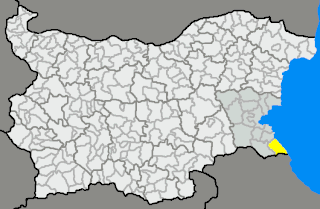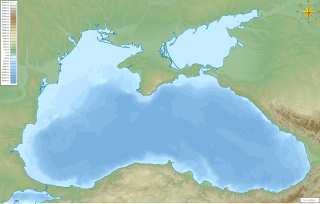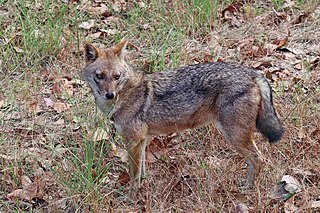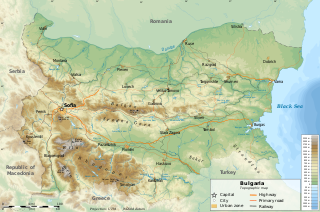
Bulgaria is a country situated in Southeast Europe, bordering Romania to the north, Serbia and North Macedonia to the west, Greece and Turkey to the south, and the Black Sea to the east. The northern border with Romania follows the river Danube until the city of Silistra. The land area of Bulgaria is 110,879 square kilometres (42,811 sq mi), slightly larger than that of Iceland or the U.S. state of Tennessee. Considering its relatively small size, Bulgaria has a great variety of topographical features. Even within small parts of the country, the land may be divided into plains, plateaus, hills, mountains, basins, gorges, and deep river valleys. The geographic center of Bulgaria is located in Uzana.
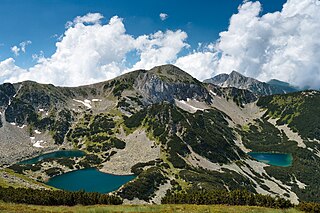
Pirin National Park, originally named Vihren National Park, encompasses the larger part of the Pirin Mountains in southwestern Bulgaria, spanning an area of 403.56 km2 (155.82 sq mi). It is one of the three national parks in the country, the others being Rila National Park and Central Balkan National Park. The park was established in 1962 and its territory was expanded several times since then. Pirin National Park was declared a UNESCO World Heritage Site in 1983. The altitude varies from 950 m to 2,914 m at Vihren, Bulgaria's second highest summit and the Balkans' third.

The Bulgarian Black Sea Coast covers the entire eastern bound of Bulgaria stretching from the Romanian Black Sea resorts in the north to European Turkey in the south, along 378 km of coastline. White and golden sandy beaches occupy approximately 130 km of the 378 km long coast. The region is an important center of tourism during the summer season (May–October), drawing millions of foreign and local tourists alike and constituting one of the country's most popular tourist destinations. Prior to 1989 the Bulgarian Black Sea coast was internationally known as the Red Riviera. Since the fall of the Iron Curtain, however, its nickname has been changed to the Bulgarian Riviera.

The Central Balkan National Park lies in the heart of Bulgaria, nestled in the central and higher portions of the Balkan Mountains. Its altitude varies from 550 m. near the town of Karlovo to 2376 m. at Botev Peak, the highest summit in the mountain range. It was established on 31 October 1991. The Central Balkan National Park is the third largest protected territory in Bulgaria, spanning an area of 716.69 km² with total length of 85 km from the west to the east and an average width of 10 km. It occupies territory from 5 of the 28 provinces of the country: Lovech, Gabrovo, Sofia, Plovdiv and Stara Zagora. The national park includes nine nature reserves covering 28% of its territory: Boatin, Tsarichina, Kozya Stena, Steneto, Severen Dzhendem, Peeshti Skali, Sokolna, Dzhendema and Stara Reka.
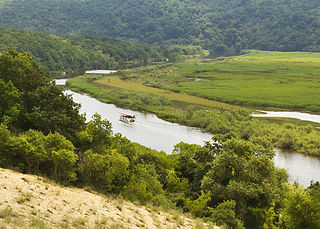
The Ropotamo is a river in south-eastern Bulgaria. It takes its source from the Bosna Ridge in the Strandzha Mountains, running for 48.5 km to empty into the Black Sea near Cape Saint Demetrius between Dyuni and Primorsko.

Rila National Park is the largest national park in Bulgaria spanning an area of 810.46 km2 in the Rila mountain range in the south-west of the country. It was established on 24 February 1992 to protect several ecosystems of national importance. Its altitude varies from 800 m (2,600 ft) near Blagoevgrad to 2,925 m (9,596 ft) at Musala Peak, the highest summit in the Balkan Peninsula. There are 120 glacial lakes, including the prominent Seven Rila Lakes. Many rivers have their source in the national park, including the longest river entirely in the Balkans, the Maritsa, and the longest river entirely in Bulgaria, the Iskar.

The Euxine-Colchic deciduous forests ecoregion, in the Temperate broadleaf and mixed forests Biome, is located along the southern shore of the Black Sea. The ecoregion extends along the thin coastal strip from the southeastern corner of Bulgaria in the west, to Georgia in the east, across the northern coast of Turkey, where it wraps around the eastern end of the Black Sea.

Silkosia is a nature reserve in Strandzha Nature Park, located in the homonymous mountain, southeastern Bulgaria. Its territory close to the villages Kosti and Balgari. Silkosia is the oldest reserve in the country, declared on 23 July 1931 in order to protect the evergreen bushes unique for Europe. It encompasses part of the Veleka river catchment area with a territory of 389.6 ha or 3.896 km2. The terrain is various, in the lower parts there are predominantly swamp areas with typical Central European flora. The reserve encompasses territory between 100 and 250 m altitude and is thus among the lowest-lying nature reserves in the country.
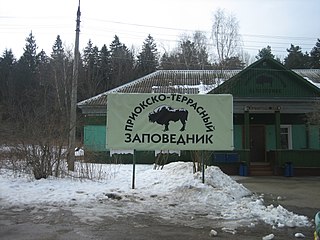
Prioksko-Terrasny Nature Biosphere Reserve is one of Russia's smallest zapovedniks, sprawling over an area of 5,000 hectares along the left bank of the Oka River in the Serpukhov District of Moskva Oblast. It was established in 1945 as part of the Moscow Nature Reserve and is home to 900 plant species, 130 bird species, and 54 mammal species. A wisent nursery was established in 1948 to populate the region with European bisons from the Belovezhskaya Pushcha and Western Caucasus. There is also a small herd of American bisons.

Lal Suhanra is a national park in Pakistan that is situated in the Bahawalpur district of Punjab province. It is one of South Asia’s largest nationals parks, and is a UNESCO declared Biosphere Reserve. Lal Sohanra is notable for the diversity of its landscape, which includes desert, forest and wetland ecosystems.
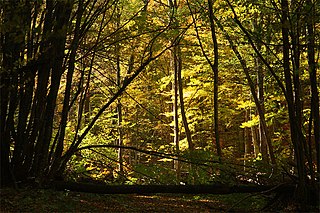
Vitanovo is a nature reserve in the Strandzha mountains of south-eastern Bulgaria. It is one of the five reserves situated in Strandzha Nature Park. It lies in south-eastern Bulgaria near the border with Turkey. It encompasses an area of 1112.4 ha or 11.124 km2. The reserve can only be accessed with a special permission, issued by the Ministry of Environment and Water of Bulgaria, for conducting research or for specialized tourism under strict rules and routes.
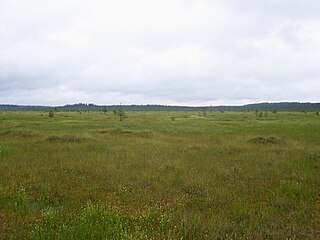
Central Forest Nature Reserve is zapovednik in the north-west of Russia, located in Andreapolsky and Nelidovsky Districts of Tver Oblast, in the upper course of the Mezha River. It was established on 4 May 1930. The nature reserve is created to protect the conifer forest in the upper course of the Western Dvina River. Since 1985, it is classified as UNESCO Biosphere Reserve.

Stara Reka is one of the nine nature reserves in the Central Balkan National Park in central Bulgaria. Stara Reka was established on 19 March 1981 to protect the unique ecosystems of the Balkan Mountains. It spans an area of 1974.7 hectares, or 19.747km2.

Bayuvi Dupki–Dzhindzhiritsa, also spelled Doupki–Djindjiritza, is a nature reserve in Pirin National Park, located in the homonymous mountain range in south-western Bulgaria. It is situated in Razlog Municipality, Blagoevgrad Province. Bayuvi Dupki–Dzhindzhiritsa is among the nation's oldest reserves, declared in 1934 to protect the forests of Macedonian pine and Bosnian pine, both Balkan endemic species. Its territory was further expanded in 1976 and 1980 and spans an area of 2873 ha or 28,73 km2. It was declared a UNESCO Biosphere Reserve in 1977. The reserve encompasses territory between 1200 and 2907 m altitude. Geologically it is dominated by Proterozoic marbles and has extensive karst terrain with numerous caves and karst formations.

Ali Botush, also spelled Alibotoush, is a nature reserve in the small mountain range of Slavyanka, located on the border between Bulgaria and Greece. The reserve occupies the northern section of the mountain which lies within the territory of Bulgaria and takes its name from the old name of Slavyanka. It is situated in the municipalities of Sandanski and Hadzhidimovo, Blagoevgrad Province. It was declared in 1951 to protect the largest forests of the endemic Bosnian pine in the Balkan Peninsula. Its territory was further expanded several times and spans an area of 1638 ha or 16,38 km2. It was declared a UNESCO Biosphere Reserve in 1977.

Tisata is a nature reserve in south-western Bulgaria. It is situated in Kresna Municipality, Blagoevgrad Province. The reserve is managed by the administration of Pirin National Park despite the fact it lies outside the limits of the park.

Kobuleti Strict Nature Reserve is a protected area in Kobuleti Municipality, Adjara region of Georgia along the Black Sea coast in the northern part of the resort town Kobuleti. Kobuleti Protected Areas were established in 1998 to preserve unique wetland ecosystems recognized by the Ramsar Convention.






